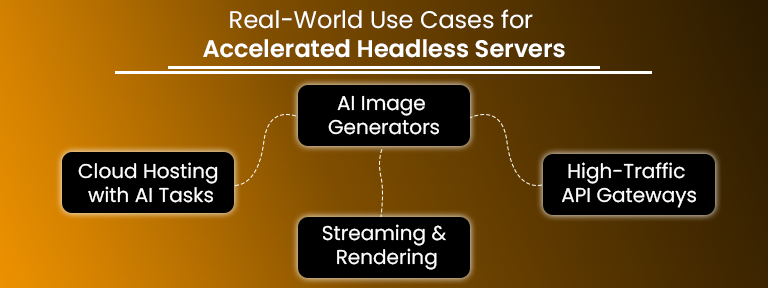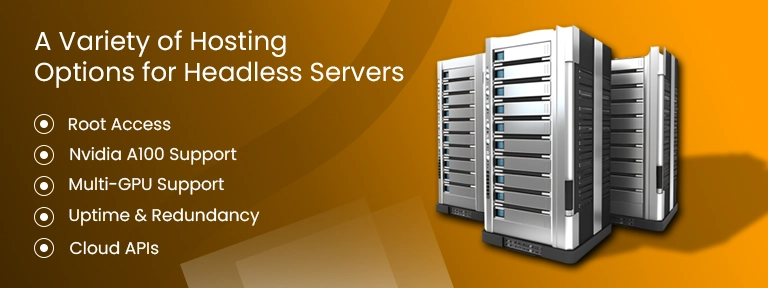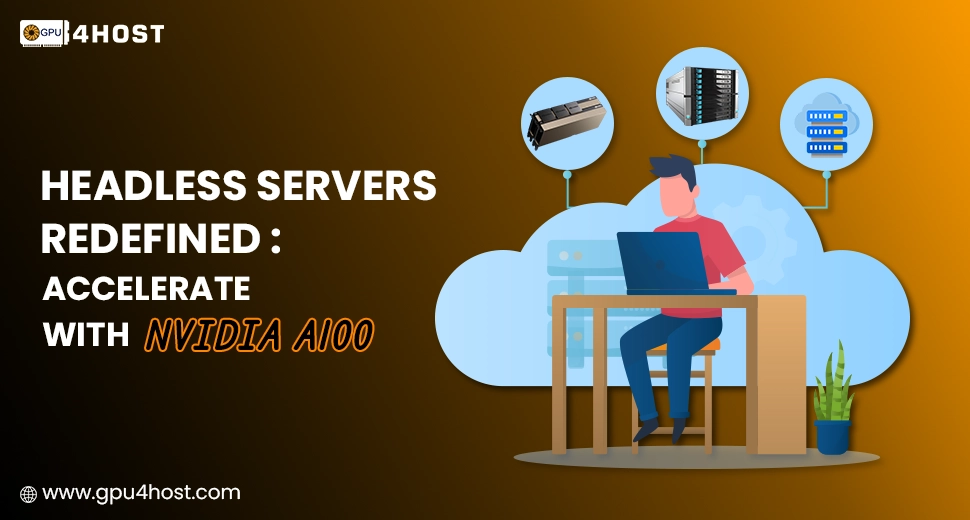Headless Servers Redefined: Accelerate with Nvidia A100
In the era of increasing dependence on AI, cloud-powered applications, and cutting-edge compute projects, headless servers have always become the unhonored heroes featuring advanced backend infrastructure. But without the appropriate hardware acceleration, even the right headless servers can become blocked.
In this knowledge base, we’ll cover how to boost headless servers with hardware acceleration, consisting of a GPU server, a GPU cluster, and AI GPU technology. We will also explore how services like GPU4HOST and technologies such as the Nvidia A100 are constantly transforming performance for different tasks like AI image generators, 3D graphics rendering, and parallel data processing.
What Are Headless Servers?
Headless servers are basically those systems that run without a standard graphical user interface (GUI). They are engineered to perform all backend processes, such as data processing, AI model inference, or web hosting, in a lightweight, productive manner, mainly when collaborating with command-line control or remote setup tools.
These servers are generally utilized in:
- AI & ML pipelines
- Cloud-native offerings
- Containerized environments
- CI/CD processes
- AI image generator backends
- High-performance graphics rendering
While headless (no monitor) servers are lean by proper design, they need demanding computing power to perform all challenging tasks productively. That’s where hardware acceleration always comes into play.
Why Hardware Acceleration Is Important
Hardware acceleration improves server performance simply by offloading compute-heavy processes to expert-level hardware, most generally, GPUs (Graphics Processing Units).
For headless servers, this flawlessly translates into:
- Quicker computation of AI-based models
- Improved image rendering
- Real-time video encoding
- Productive management of concurrent requests
- Decreased CPU load
Modern GPU servers, mainly all those utilizing Nvidia A100 chips, are enhanced for deep learning, AI model training, and inference, making them a perfect competitor for boosting servers.
Real-World Use Cases for Accelerated Headless Servers

Let’s have a look at how hardware-powered no-monitor servers get an advantage from real-world apps:
1. AI Image Generators
Services such as Stable Diffusion or Midjourney work on GPU clusters behind no-monitor servers. Hardware acceleration dramatically decreases the time to produce challenging images from textual prompts.
2. Cloud Hosting with AI Tasks
Enterprise-based hosting AI microservices on headless servers utilizes AI GPUs to decrease response latency and power productive real-time inferencing.
3. High-Traffic API Gateways
At the time of managing thousands of simultaneous API requests—mainly for services such as GPU hosting or GPU cluster orchestration—hardware acceleration guarantees that performance doesn’t reduce under heavy load.
4. Streaming & Rendering
Rendering video-based content or 3D graphics on a GPU dedicated server without a GUI interface (which is headless) enhances frame processing and encoding speeds.
Selecting the Right Hardware for Headless Servers
To get the best from your GUI interface servers, combine them with the appropriate GPU hardware. Here’s how well-known setups stack up:
| Component | Recommended Hardware |
| AI Tasks | Nvidia A100/A40 GPUs |
| 3D Graphics Rendering | Nvidia RTX 4090/A6000 |
| Image Generation | Dual GPU setups with 24–80 GB VRAM |
| Parallel Processing | Multi-GPU Cluster Nodes (e.g., 4x A100s) |
When you select a GPU server along with tier-4 architecture and powerful GPU-to-CPU ratios, you easily remove all bottlenecks generally found in low-powered headless environments.
Software Considerations for Accelerated Headless Servers
Even with the right hardware, your software stack must be enhanced to completely use acceleration.
- Utilize Headless Mode in Applications
Tools named Blender, Chromium, and TensorFlow provide headless process flags (–headless, –no-gui) that make sure that no assets are wasted on graphical rendering.
- Enable GPU Acceleration
Make sure that your frameworks are fully compiled with ROCm (for AMD GPUs), CUDA (for Nvidia GPUs), or compatible AI-based libraries.
Example: Utilize TensorFlow along with GPU support in your AI image generator configuration.
- Optimize I/O:
Quick data pipelines utilizing NVMe storage or RAM disks can prevent any type of slowdown from disk blockage.
- Utilize Containerization:
Docker containers set up with full GPU access (nvidia-docker) help adjust all headless apps in a distributed GPU cluster.
A Variety of Hosting Options for Headless Servers

At GPU4HOST, we offer completely personalized GPU dedicated server configurations perfect for running boosted headless servers.
- Root Access: Set up the server headlessly from the CLI.
- Nvidia A100 Support: For AI, model training, and inference.
- Multi-GPU Support: Perfect for distributed tasks.
- Uptime & Redundancy: Hosted in Tier-4 data centers.
- Cloud APIs: Add with AI image generator pipelines or ML-based platforms.
Even if you are building a new product or managing enterprise tasks, GPU4HOST provides the scalability to deploy headless, GPU-based infrastructure globally.
How Headless Servers Compare with Standard Servers
| Feature | Headless Servers | Standard Servers |
| GUI Interface | None (CLI or remote only) | Complete GUI with desktop environments |
| Performance Overhead | Very less | Moderate to high |
| Best for | AI, cloud APIs, automated pipelines | Desktop apps, 3D graphics rendering, CMS |
| Scalability | Smoothly scaled with containers/clusters | Generally limited by software dependencies |
| Hosting Type | Perfect on a GPU dedicated server or clusters | Usually hosted on traditional VMs |
Building a Powerful Architecture with Headless Servers
Here is a general structure for a flexible deployment utilizing headless servers along with hardware acceleration:
- Load Balancer: Allocate traffic across different nodes.
- API Gateway: Route requests to GPU-powered microservices.
- Headless GPU Nodes: Every single one featured 1–4 Nvidia A100s or RTX GPUs.
- Storage Cluster: Quick, shared NVMe or object storage.
- Monitoring Stack: Prometheus + Grafana for engaging performance insights.
This type of configuration is perfect for businesses providing GPU hosting, AI-based applications, or media platforms.
Security Considerations for Headless Environments
- SSH Access Only: Disable GUI-powered access tactics.
- Firewall Rules: Whitelist only important ports.
- Use Headless Linux Distros: Rocky Linux or Ubuntu Server.
- GPU Monitoring Tools: Check thermal load and utilization (for example, nvidia-smi).
Since headless servers are generally exposed with the help of SSH or APIs, always apply 2FA and automated patching mechanisms.
Final Thoughts
Headless servers usually provide blazing-fast speed, scalability, and low overhead, but to get their complete power, hardware acceleration with robust GPUs is very important. Even if you are running AI-based tasks, featuring an AI image generator, or quickly deploying compute-intensive backend services, pairing headless architecture with a GPU dedicated server gives you a performance advantage.
At GPU4HOST, we are experts in developing a cutting-edge GPU server especially for developers, scientific researchers, and new businesses across the globe. Ranging from Nvidia A100 clusters to edge-enhanced deployments, we are right here to help you scale smart, with high speed and security.


